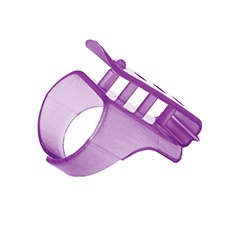Color Dominance
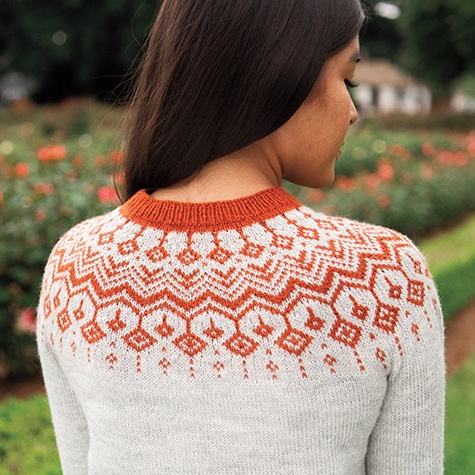
A critical thing to keep in mind when knitting colorwork is where you're holding your main color (MC) vs. your contrast color (CC). Switching which strand is held to the left or right of the other creates starkly different results in colorwork knitting; this concept is known as “color dominance.” The “dominant” color in a pattern is not necessarily the same as your MC—in fact, it usually should be exactly the opposite.
Think of the dominant color as the one creating the design rather than the one creating the background. You want the design to appear as if it’s laid over the top of the background color, rather than trying to peek through from underneath. Holding the CC as the dominant color, then, makes sure this is the look you get. Of course, which color you want to be the dominant one is entirely up to you—and since it’s actually a pretty fun experiment to try this, switching which color is dominant and which is not, you can try both out on a colorwork swatch before you cast on to see which you prefer.
No matter what you decide, the dominant color should always be held to the left of the non-dominant color—whether on one finger, in a Yarn Guide, or in your left hand while the other strand is in your right—and you should keep this consistent throughout the whole project.
Yarn Tension In Colorwork

Even if you don’t struggle with tension or gauge when knitting with one color, knitting colorwork with multiple strands requires some adjustments.
Holding both strands of yarn too tightly can result in fabric that is taut and puckered. Holding them too loosely can make the fabric look messy. Some knitters go up a needle size (or two or three) just for the colorwork portions of a garment—using US 9 needles on a colorwork yoke of a sweater that’s otherwise knit with US 6 needles, for instance. Some simply experiment with how they hold the yarn until they get a fabric they like.
Wrapping floats can help, but even if you’re wrapping stitches frequently, you still want to be conscious of carrying the unused colors at the back of the work loosely. Remember, loose stitches or strands can be tightened, but it’s virtually impossible to loosen stitches that are too tight.
Nervous about your first colorwork project? Start small! Hats or even can koozies can be excellent beginning projects for stranded colorwork.
Managing Multiple Strands of Yarn
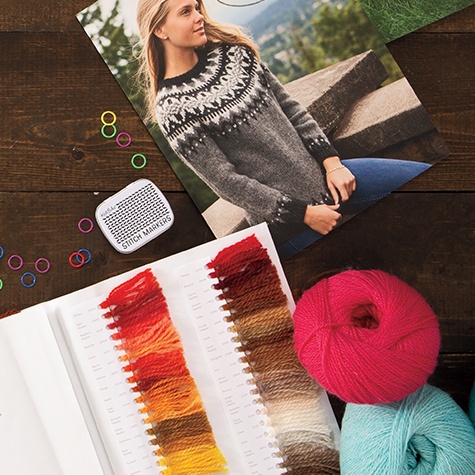
One of the challenging things about colorwork is working with two (or more!) yarns at a time. While you could work with one color at a time, constantly dropping one and picking up the other and then back again, this is a very slow method and one that’s more likely to result in frustration.
Keeping your colors organized and finding a way to hold the yarn so that it doesn’t twist or get tangled, then, is key to working with multiple colors.
There are several ways knitters do this, and the “right” choice is the one that feels most comfortable to you and that allows you to get the most even tension in your knitting. All of them take some getting used to, so try each method and then spend some time practicing (preferably on a small project or even a swatch) the one you prefer.
You may only see one color in each stitch on the front of a project, but remember that there are as many layers to the fabric as there are strands of yarn. Colorwork garments are extremely warm because of this—they’re twice as thick!
Keep in mind that if the pattern you’re working on has significantly more stitches with one color vs. the other, you may need to readjust your tension frequently as you pull from one strand more than the other.
Carrying Two Strands in One Hand
If you only feel comfortable as either a “picker” (Continental knitter) or a “thrower” (English knitter), then you may want to hold both strands of yarn in the same hand. Whether you hold the yarn in your left or right hand, it’s important to keep the strands separate enough that you don’t accidentally “pick” or “throw” the wrong one.
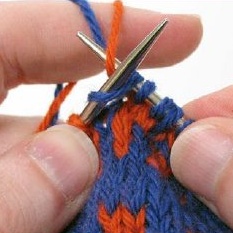
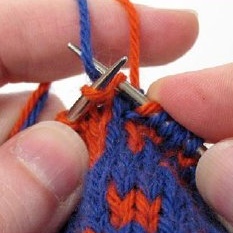
Using a Yarn Guide
If you’d like to stick to carrying the yarn with only one hand but you’re having trouble keeping the yarn strands apart, there are tools to help. We recommend a tool called a Yarn Guide that slips over your finger like a ring, halting at or near your first knuckle, with a multi-channel top that keeps each yarn strand in its own pathway.

Simply open the latch, lay each strand in its own channel in the Yarn Guide, snap the top shut, and you’re ready to go. You may still need to readjust your tension regularly if one yarn is used more than the other, as is the case when just carrying two yarns in one hand without the Yarn Guide.
"Scandinavian" Knitting
If you are (or can get) comfortable with either left-hand or right-hand knitting, you may find that holding one strand in each hand is the easiest way to knit colorwork. This method (pictured below), sometimes called “Scandinavian” knitting, is the one endorsed by Elizabeth Zimmerman in Knitting Without Tears.
Note:
Keep one ball of yarn on either side of you while you’re knitting, so you’ll not only keep the strands in your hands from getting twisted, the yarn balls stay tangle-free, too.
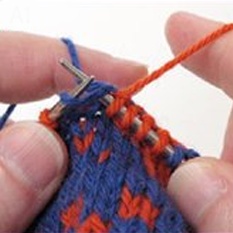
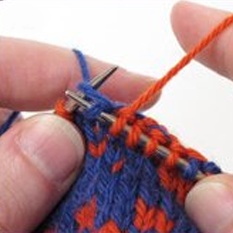
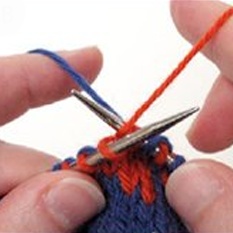
Wrapping Floats
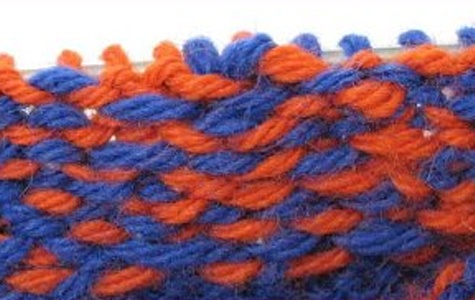
To keep the back of your work tidy, you may want to consider securing the longer loose strands, or “floats,” by wrapping the two yarns while you’re knitting. Most knitters would probably leave shorter floats (with three stitches or less) alone, but floats of five or more stitches may benefit from wrapping. Keep in mind that wrapped floats may sometimes be visible from the front of the work, so test it both ways before getting too far into a project.
There are two commonly used techniques for wrapping the unused color behind your work while you are knitting your multi-color project. With a little practice, you can master these techniques and they will become indispensable in working with color patterns.
Wrapping Yarn from Your Left Hand
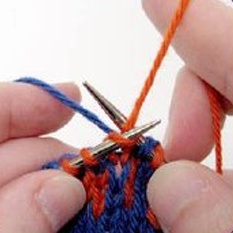
Step One
When you come to the stitch you want to wrap, put your working needle into the stitch on the left-hand needle and then also under the yarn strand on the left hand.
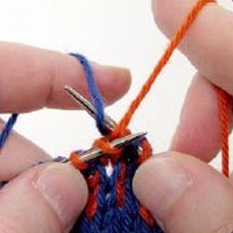
Step Two
Next, wrap the right-hand strand of yarn around the working needle to knit it—but before you pull it through, push the left-hand yarn strand back off the working needle.
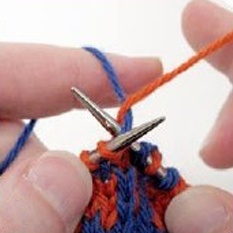
Step Three
The only color you knit to create a new stitch is the one from your right hand.
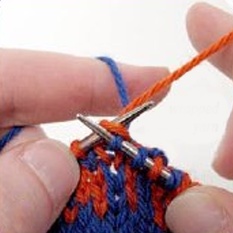
Step Four
You’ll see the left-hand yarn strand is wrapped behind that stitch, keeping it tame.
Wrapping Yarn from Your Right Hand
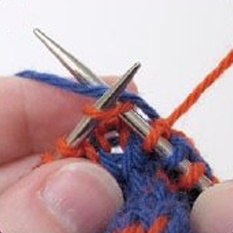
Step One
When you come to the stitch you want to wrap, put your working needle into the stitch on the left-hand needle and wrap the yarn from your right hand around the working needle as if to knit it—but don’t.
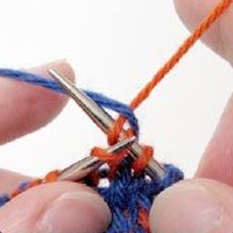
Step Two
Next, start to knit from the yarn in your left hand.

Step Three
Before you pull the left-hand yarn through, push the right-hand yarn strand back off the working needle.
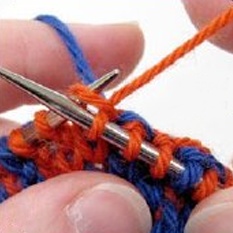
Step Four
The only color you knit to create a new stitch is the one from your left hand.
How Often to Wrap Floats
Some knitters like to wrap floats frequently and regularly, while others do so when the floats “feel” too long for their taste. Whichever camp you fall into, note that you must have “normal” (non-wrapped) stitches on either side of every wrapped stitch or the weaving effect won’t work. Also note that if you have several rows in a pattern that may require wrapping, don’t wrap at the same places in each row—that can make the fabric look strange.
Note:
If your stitches are twisted, then you are bringing the yarn through the wrong way.



